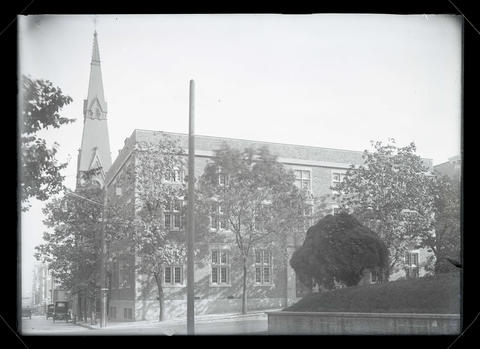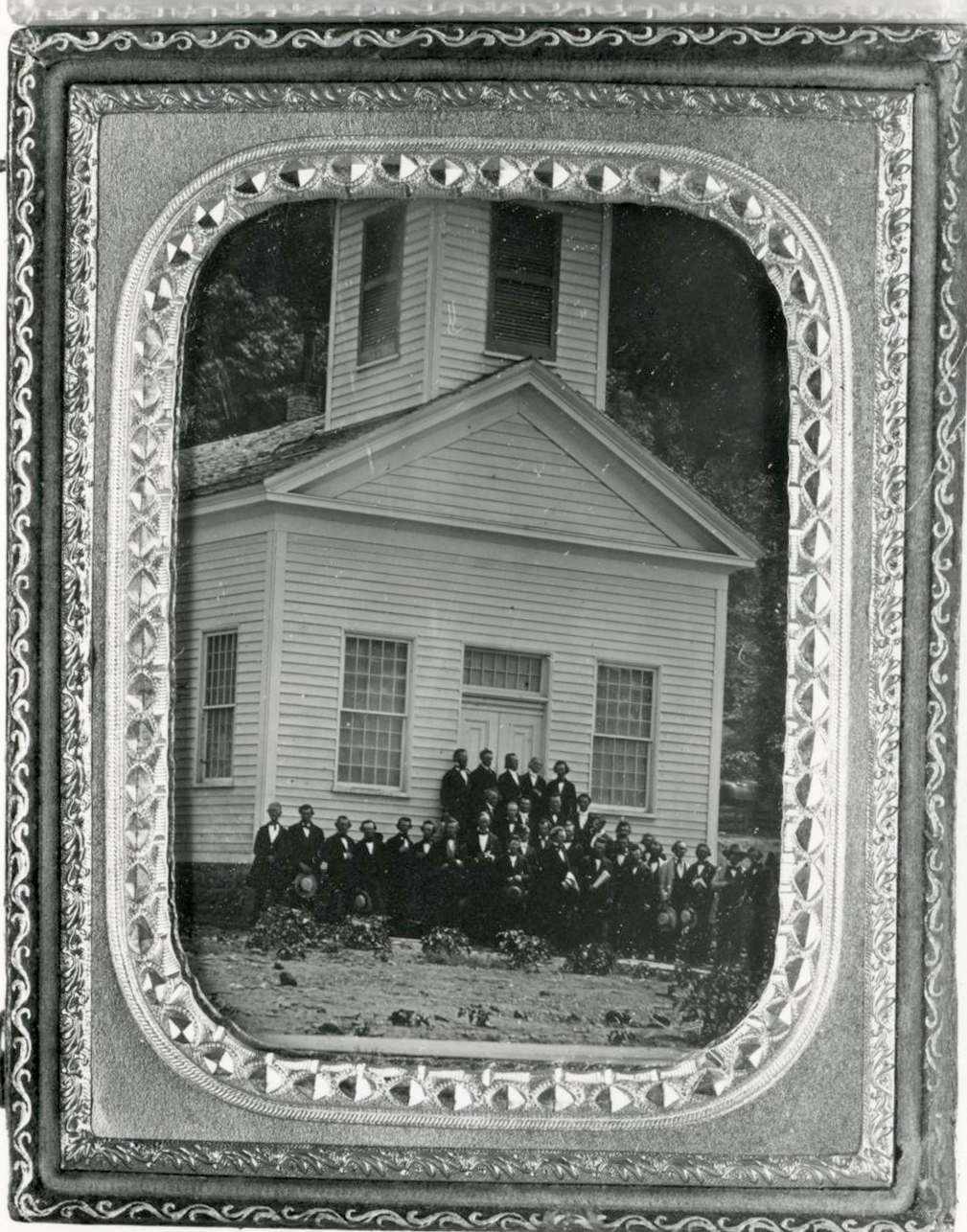First Presbyterian Church of Portland, organized in January 1854 just three years after the city was incorporated, was the third Presbyterian church in the Oregon Territory. Among its members were many prominent Portland families, including Ainsworths, Corbetts, Couches, Kamms, Ladds, and Schuylers. The first permanent sanctuary of the church, built in 1864 and boasting the city’s first pipe organ, was located on Third and Morrison. It was a “beautiful structure,” the Daily Oregonian reported on May 21, 1864, “an especial ornament to our city.” The church moved to its current location on Southwest 12th and Alder in 1888.
The church’s sanctuary, designed by William F. McCaw, is high Victorian Gothic with open-beam timber construction, one of the finest in the United States. The chancel, choir loft, and organ were carved by Nicholas Strahan in an oak leaf design in the Gothic tradition. Strahan also carved the pulpit, pews, ornamentation, and balcony railings. Stained glass windows portray biblical fruit and flowers, and the dominant east window contains a cross made of chunks of split and fractured glass, with a white dove descending on the cross. The windows are the work of David Povey of Povey Brothers Art Glass Works in Portland. The church’s copper-covered spire rises 185 feet. The 900-pound bell, the oldest in the city, was cast from Civil War cannons. It was installed in the church’s first building and has been in continuous use since. It tolled at the death of President Abraham Lincoln.
The musicians at the First Presbyterian Church, which is known for its music programs, have served long tenures. Edward Coursen was organist from 1890 until 1930; in 1902-1903, he also served as the conductor of the Portland Symphony Orchestra. John Stark Evans was organist and then choirmaster from 1935 to 1956; he also taught at the University of Oregon and then was head of music at Lewis & Clark College during those years. James Welty, of Northwestern University and a student of organist E. Power Biggs, was organist and choirmaster at First Presbyterian Church for thirty-seven years (1956-1993). The church’s 1929 Moeller was at one time the largest pipe organ on the Pacific Coast; it was replaced by a 52-rank Jaeckel pipe organ in 2000.
Early in its history, the church was instrumental in starting twenty-one other congregations in Oregon, as well as missions in Idaho and Alaska. It provided social services, from feeding hungry, unemployed men in the church’s Mariner House on Third Street during the 1890s economic depression to providing food and shelter for homeless women and children in its People’s Institute on Burnside during the Great Depression. In that building, First Presbyterian Church allowed the Holt Chinese Church and the Japanese Presbyterian Church to hold services.
First Presbyterian Church was among the ten largest congregations in the United States in the 1920s. In 1926, the church established Friendly House, a community center in Northwest Portland. In 1950, it purchased Menucha, Governor Julius Meier’s summer residence in the Columbia River Gorge, and developed the estate into the Menucha Retreat and Conference Center.
Thirteen senior pastors served First Presbyterian Church from 1854 to 2008. By far the longest-serving in the history of the church was Paul S. Wright, who was pastor from 1941 to 1973. Wright led First Presbyterian through World War II, the Korean and Vietnam wars, and the cold war as the church and nation struggled with theological and social crisis. He was one of the most respected religious leaders in Portland and the Northwest, and church membership under his leadership grew to more than 3,000 people. He was elected as moderator of the Presbyterian Church in the United States in 1955-1956. In the 1960s, during Wright’s tenure, First Presbyterian Church was a leading financial contributor to home missions.
The First Presbyterian Church building was placed on the National Register of Historic Places in 1974.
-
![]()
Church house, First Presbyterian Church, Portland, c.1920.
Oregon Historical Society Research Library, Digital Collections, Oregon Journal Negative Collection; Org. Lot 1368; Box 376; 376G0184
-
![]()
First Presbyterian Church, Portland, with steeple damaged by lightning, 1920.
Oregon Historical Society Research Library, Digital Collection, Oregon Journal Negative Collection; Org. Lot 1368; Box 376; 376G0315
Related Entries
-
![First Methodist Church (Portland)]()
First Methodist Church (Portland)
Methodist Episcopal Church, Portland's first church, began with seven m…
-
![First Unitarian Church (Portland)]()
First Unitarian Church (Portland)
In 1866, the Ladies Sewing Circle, a small group of Portland women from…
-
![Friendly House, Inc.]()
Friendly House, Inc.
The Marshall Street Community Center, founded by the socially minded Fi…
-
![Menucha Retreat and Conference Center]()
Menucha Retreat and Conference Center
Menucha, a prime northwest conference center, is located on a windy blu…
Map This on the Oregon History WayFinder
The Oregon History Wayfinder is an interactive map that identifies significant places, people, and events in Oregon history.
Further Reading
MacColl, E. Kimbark, and Harry H. Stein. Merchants, Money, and Power: The Portland Establishment, 1843-1913. Portland, Ore.: The Georgian Press, 1988.
MacColl, E. Kimbark. The Shaping of a City: Business and Politics in Portland, Oregon, 1885-1915. Portland, Ore.: The Georgian Press, 1976.
Weaver, J. Dudley, Jr. A Legacy of Faith: First Presbyterian Church, Portland. Aloha, Ore.: Beachwalker Press L.L.C., 2004.






